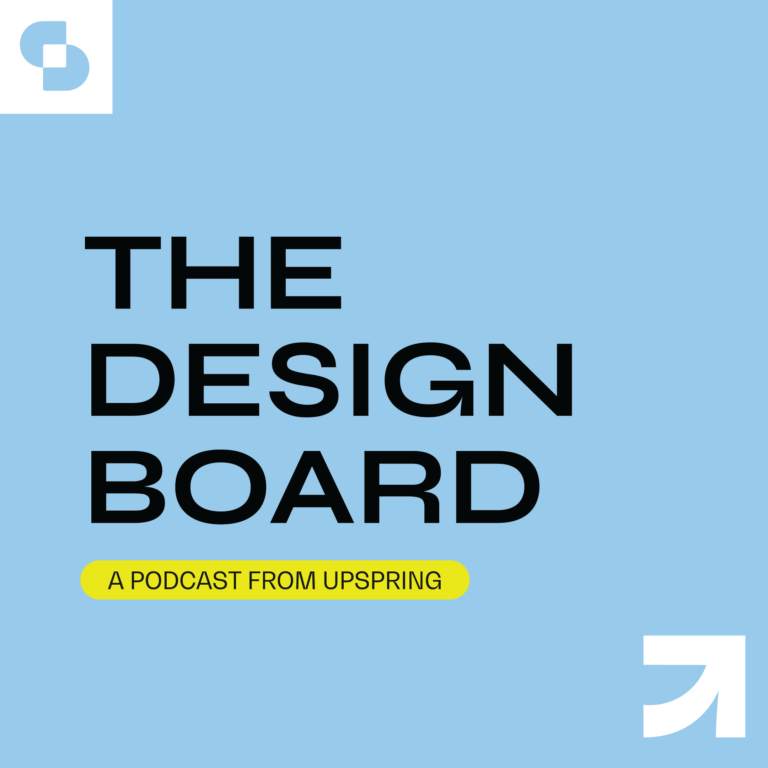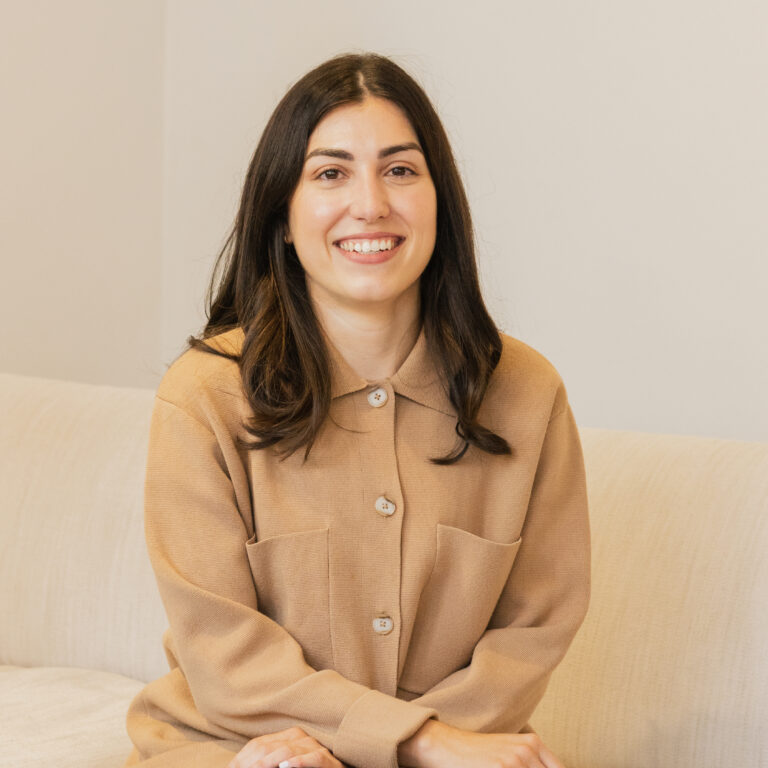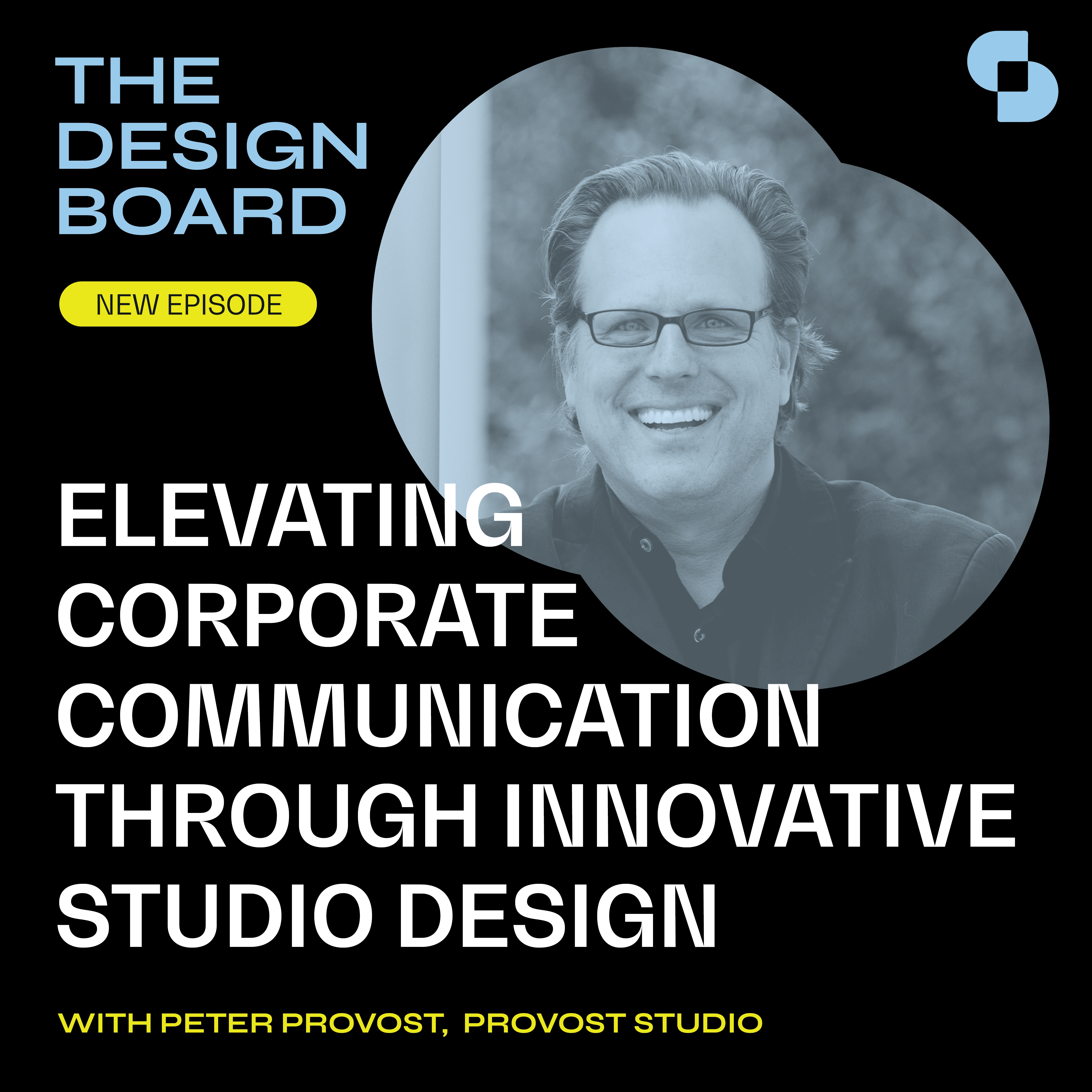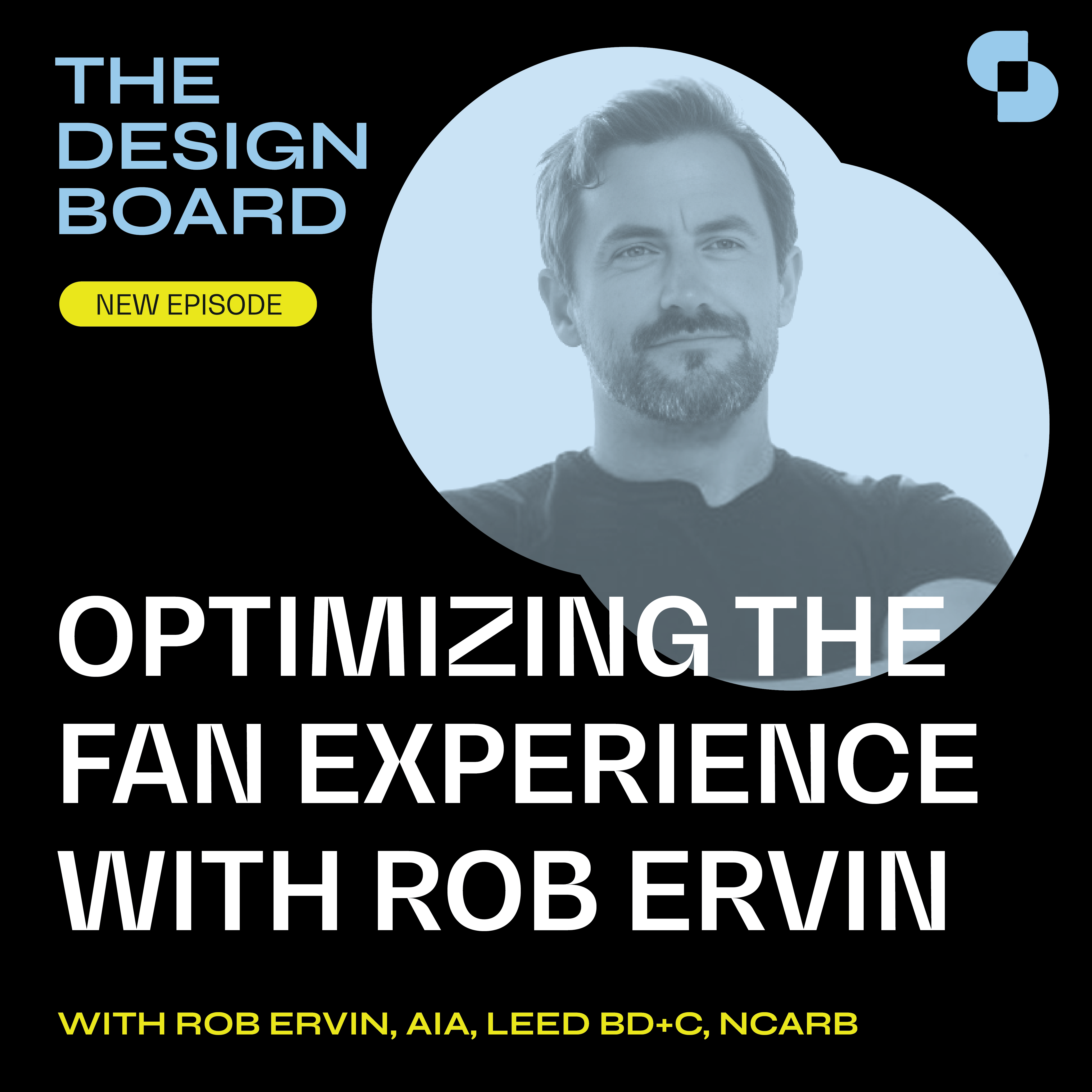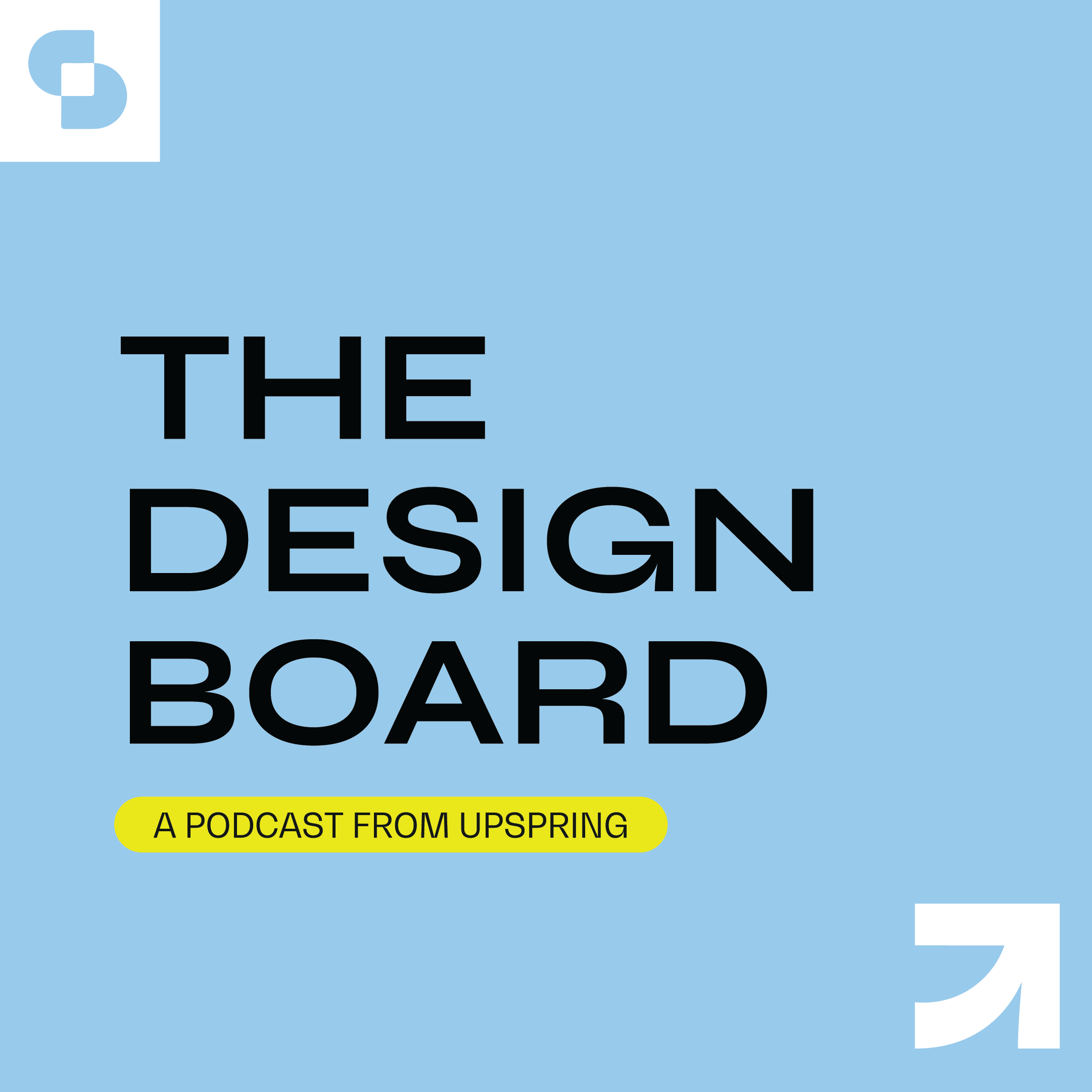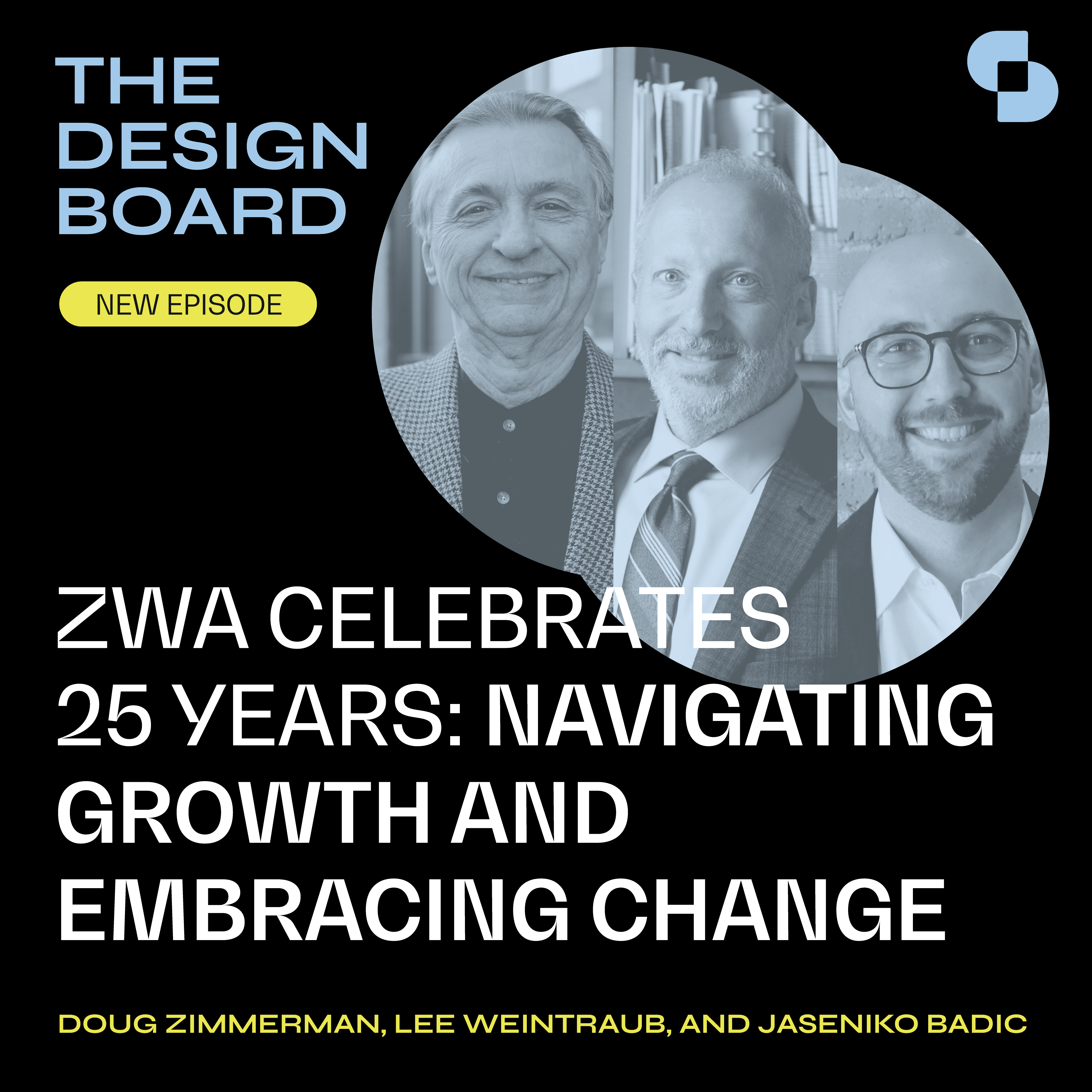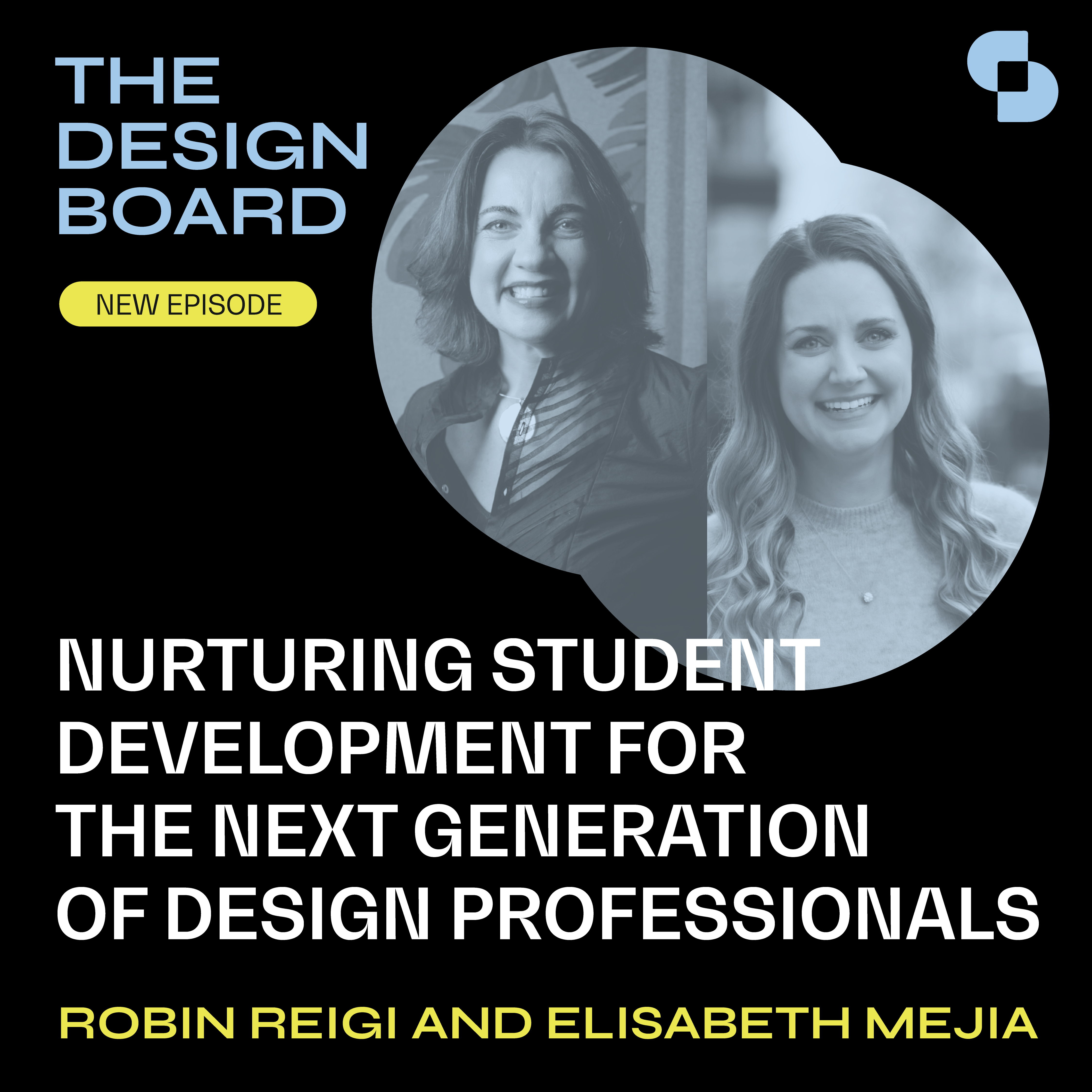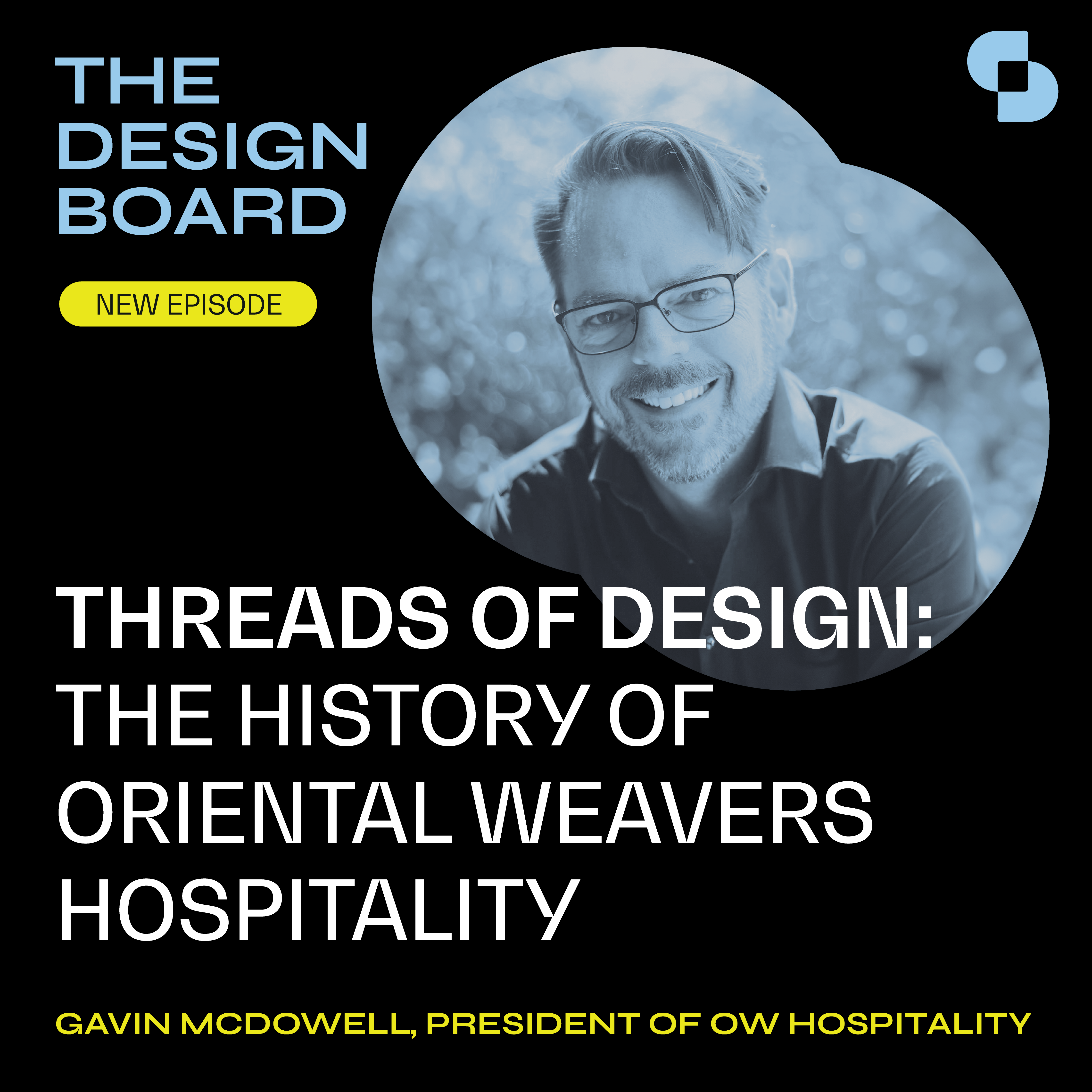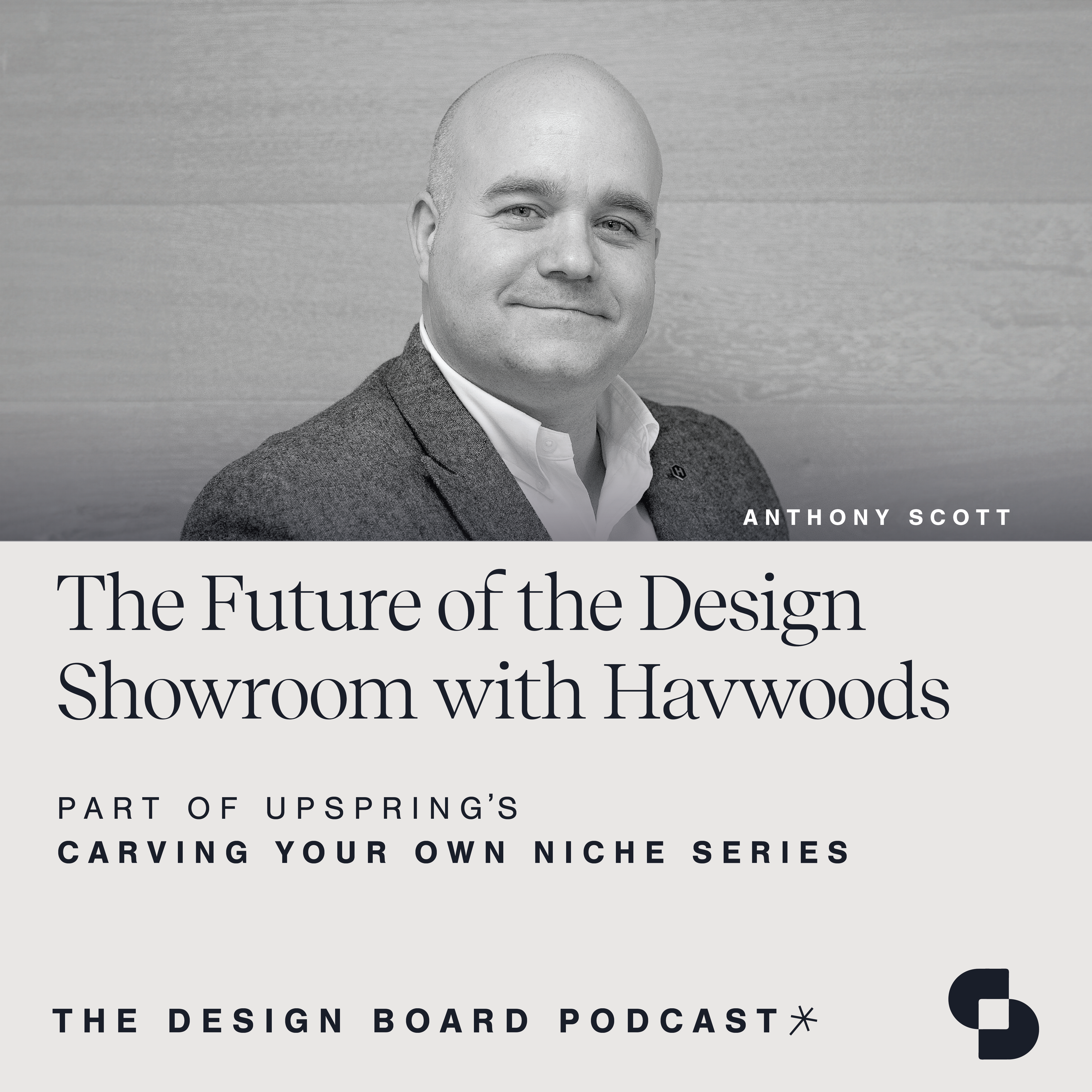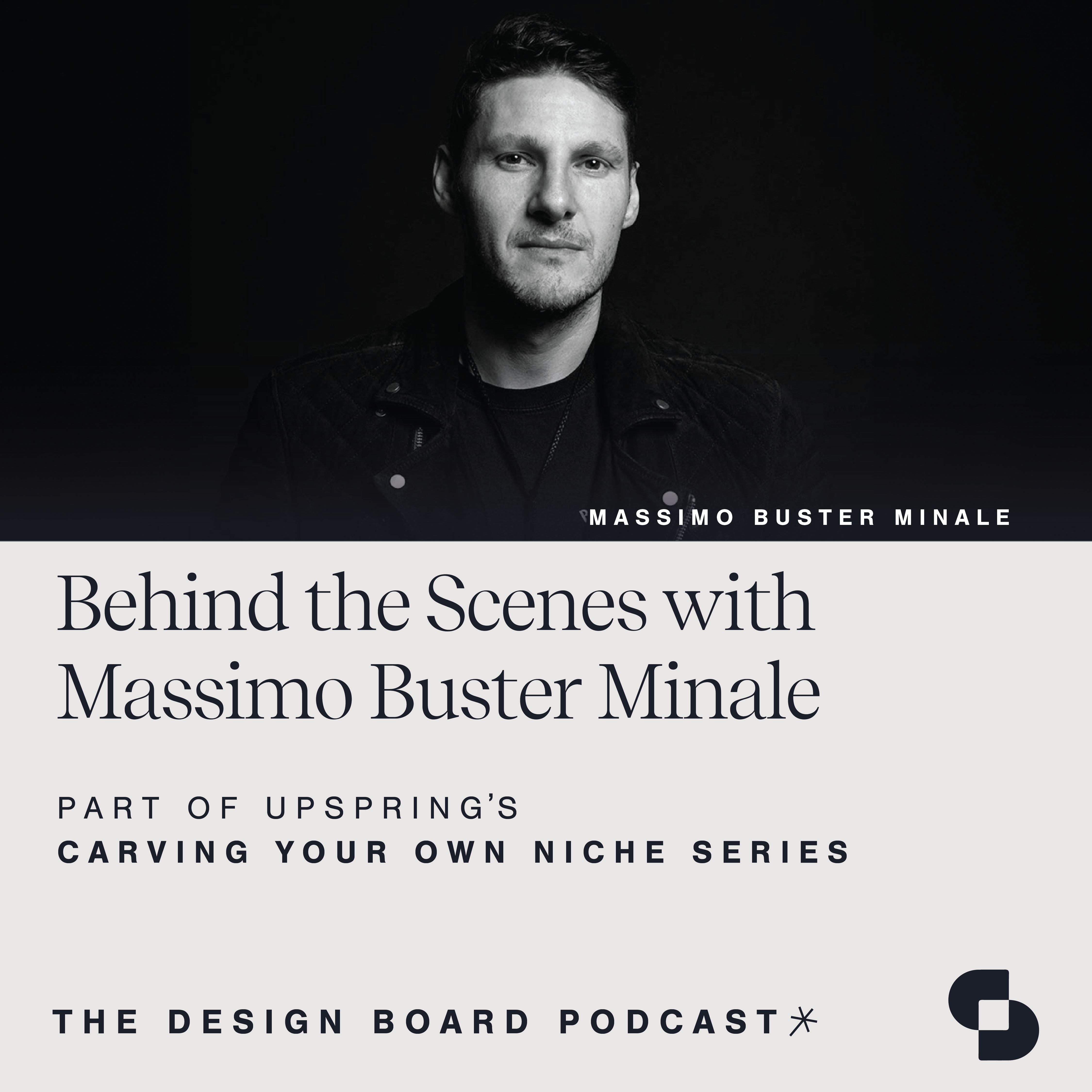Join us on an inspiring journey as we delve into the founding story of Artaic, an innovative company that seamlessly blends art and technology to redefine the world of mosaic art. In this podcast, host Susan Fernandez sits down with Ted Acworth, Founder & CEO of Artaic, to explore the vision behind Artaic and the motivations that drove its inception.
The Design Board, by UpSpring, is a proud member of SANDOW Design Group’s SURROUND Podcast Network, home to the architecture and design industry’s premier shows.
Although the transcription is largely accurate it was generated in part by an automated service. In some cases it is incomplete or inaccurate due to inaudible passages or transcription errors.
Announcer: Welcome to the Design Board, a podcast created by the team at UpSpring that focuses on design, development, and everything in between. We invite innovators in our industry and explore topics that support your growth in every way. The Design Board is a proud member of SURROUND, a podcast network from SANDOW Design Group featuring the architecture and design industry’s premier shows. Check it out at surroundpodcast.com.
Susan Fernandez:
Welcome everyone to The Design Board, a podcast by UpSpring that focuses on design, development, and everything in between. We host innovators in our industry and explore topics that support your growth in every way. I’m Susan Fernandez, Vice President of Digital Marketing at UpSpring, a PR and digital marketing agency dedicated to the design industry.
Today, I am so excited to be joined by Ted Acworth, Founder and CEO of Artaic, for a conversation about how he built this. For a little bit of background, Artaic is a company that specializes in the creation of custom mosaic tile artwork. You really have to see this to believe it. It is amazing. They combine advanced technology with traditional craftsmanship to produce stunning and intricate mosaic designs. Ted, I want to welcome you, and before we get started, your headquarters is in Boston, so tell me what is up with the Empire State Building behind you?
Ted Acworth:
Hi, Susan. Great to be here. Thanks for having me on your show. To answer your question, I’m actually a New Yorker. I was born, raised in New York. I went to college and did my master’s degree at Columbia in Manhattan. And I ended up after living in some different places around the world and traveling in Boston. And our very, very first trade show that we did when we were a tiny little startup was at the ICFF, International Contemporary Furniture Fair, in the Javits Center in New York. And I’m thinking 14 years ago, we had a little 10 x 10 way in the back corner and we wanted to make a custom mosaic to showcase what we can do. And this was one of our very first mosaics was a mounted and framed portable Empire State Building. We specialize in customization and personalization, so we felt that this would be a great way to demonstrate that in the New York market. And I ended up keeping it because I’m from New York, so it’s been great to have here up in Boston.
Susan Fernandez:
It’s fantastic. It’s really beautiful. For those of you who are just listening, check out our links to see Artaic’s work in action and hopefully we’ll get a link or at least a post-it of this beautiful mosaic.
So Ted, can you tell us how Artaic was founded?
Ted Acworth:
Sure. It was a sort of light bulb idea moment, kind of a crazy idea I’d say. I kind of brought together a few things in that moment. My background is in science and engineering, PhD work for NASA doing optics and image processing and precision mechanical things and robotics. And so I’ve had this background in technology and a skillset that I developed, one part of it. Another part of it was I had just finished spinning out a company from MIT and it had done well and I’d really kind of caught that bug of doing technology startup companies and I wanted to do another one.
And I think the third thing was I had somewhere in the back of my brain this passion for mosaic artwork. And my mother is a commercial artist. So growing up as a kid, I was on job sites seeing how commercial artwork gets done. So I had a sense of that. And I discovered mosaic traveling in Europe as a kid and just fell in love with the medium, the artistic medium because it’s so physical and durable and tangible. And as a mechanical engineer, that’s the sort of format or medium that I gravitate towards.
And so the idea of Artaic was really bringing those three things together. What could I do with my technology knowledge? What could I do with another new startup company? And I want to do it in an area that’s in the creative and artistic space around mosaic.
Susan Fernandez:
Well, I think you’ve answered my second question, which was going to be how did you integrate this technology into the creation of Artaic? But really interesting that you’ve kind of are straddling both right brain, left brain so that really beautiful creative, that innate need that we have to be creative, and then combining this really almost scientific approach, technology, how can we create in a way we’ve never created before.
Can you tell me a little bit about your previous experiences and how they played a significant role in shaping the vision and direction of your company?
Ted Acworth:
I would say my tech background was the biggest factor. Like I said, I come from an engineering, scientific background. I have these skillsets as an engineer, and it was more about where could I apply those in the next step in my career, where would I like to work with those? And I decided to work in the world of creative and artistic architecture and design with the mosaic medium.
That was a primary influencer is that I come to this industry as a geek engineer, not as an architect, not as a designer, at least not an aesthetic designer. I do design, but it’s in the engineering domain. I think of Artaic as a tool that I’ve built that enables creatives to do more creative things. So even internally at Artaic, our staff, we’re about 25 people and we have a full-service design department that works with our clients, they think about visual design. Artaic has the tools they can wield to create stunning designs for Artaic’s clients. So at the end of the day, I think of myself as the tool builder, and then we have users who use the tool to enable them to be more creative.
Susan Fernandez:
Mosaics are just an ancient expression of design. They’re both functional and beautiful. Were there any specific challenges or gaps in the field of mosaic art that you wanted to address through Artaic’s innovative approach?
Ted Acworth:
Yes, there are traditional mosaic styles. I’ve been a student of mosaic for a couple of decades now. The term opus is Latin for work, the term work. And so all the different forms of mosaic are known by opus this or opus that. The most common being opus regulatum, which is a regular grid style mosaic like the one behind me where you have square tiles in a row column. That’s one of the sort of simplest forms of mosaic. A more sophisticated is opus vermiculatum, which is where you cut the tiles and you kind of do the outline of objects in the artwork with tiles. Opus paladanium, which is a kind of the broken, smashed tile like Gaudi popularized in Barcelona, Spain.
So certainly there are these different mosaic traditional forms out there that inform what we do at Artaic. But I’d say these days, while I certainly draw from that 2000-year-old history of mosaic, I get as much if not more inspiration from the artists that we get to work with as a company. We do have our own in-house design art department that serves our mainly A&D specifier client base, but we also have an art department, an art program where we work with professional artists who are winning commissions to install their artwork in public places.
It could be a government public space, like a airport or a bus terminal, or it could be a commercial public space, like the headquarters for a large pharmaceutical company where people are coming into a building and seeing a public artwork there. And those are commissions that artists compete to win. And we love working with these artists to help them win those commissions. And then we work with the artists to interpret their artwork in the medium of mosaic and then we fabricate it and get it installed.
That’s not a narrow mosaic artwork field. That’s any artwork. We work with artists who are painters or any other medium who have established themselves as artists and who can win a major commission. But perhaps, for example, they’re an artist, but it’s a floor in a lobby of a hotel. You can’t paint that as an artist and have it last and be durable. So we enable them to win that commission and do it in a physical form that’s durable and appropriate for the location. So we get inspiration from these various artists that we get to work with. It’s fabulous.
Susan Fernandez:
Yeah. So you guys are working directly with artists on these commissions and then you’re working with a lot of interior designers to bring their vision to life. So what is the process like of creating? Is this a collaborative experience? What’s it like to work with Artaic?
Ted Acworth:
The first thing is we’re not selling technology. Our customers aren’t buying robots or CAD software or all this tech. What we think our customers care about is what matters. We have to understand what our customers care about. What they care about is I think first and foremost the ability to personalize or customize the projects that they’re working on for their clients. They want to be able to show a broad creative range or scope of things they can do for their client. And enabling them in the domain of tile to do things that are much more customized and bespoke, I think really makes them stand out with their client.
So that’s sort of our primary goal is to give them that capability and their toolkit of products that they’re wielding for their client. And what that means is they care about being able to conceptualize and render a piece first. You have to be able to render it and show what it looks like visually, and then you have to be able to physically sample it as well. And only when you’ve done those things well and quickly and with a sort of delightful collaborative process do you, hopefully, win the specification and get the order and actually get to make the mosaic later.
So we focus a lot of our energy and our technology and our process on that front side of the business. And Artaic equips our people with these tools to be able to deliver that amazing level of service and customization. So we aim to do renderings within a day. We aim to do custom samples within a day. And we have a very collaborative team here who loves to work closely with our clients to listen to what they’re looking for and then deliver renderings and samples accordingly.
Susan Fernandez:
Ted, so for those who are thinking about entering this market. So here you are with this incredible technology that really allows designers and artists to use a medium that they really, would not be accessible to them at this time to do these types of really elaborate, beautiful, beautiful pieces. And you’ve got this idea, you’ve got the technology, you understand the science end of all this, how we’re going to make it happen, and as you’re talking about working together with designers and artists, I’m really struck by, for those folks who are outside of the industry or are thinking about getting into this world, how much work you do upfront in the sampling, in the collaboration. Was that a surprise to you in this business of just how much designers, architects, artists really need to see the sample, to hold it in their hands to see what you’ve created before they’re willing to invest any further?
Ted Acworth:
I was surprised when I got into the industry to find just how much work upfront needs to get done to win a specification. Again, I came to this more from a technology background. There’s obviously a very, very high cost in manufacturing mosaics. Most of it’s now done overseas in low-cost countries because there’s just so much labor and therefore cost, and that must make it really inaccessible. So I started with the idea of a robot that would really cut the labor costs and accelerate the production and enable us to do it domestically and more responsibly and in a more customized manner. Then I realized that in order to get to manufacture the mosaic, you have to be able to work with a client to design that mosaic, and so sort of backed into it.
When I started Artaic, I was thinking more about the manufacturing side and making that more cost-effective and fast and customizable. And then I realized as I got the company started and started meeting with customers that you need to win the specification. So you have to be able to design it and sample it and go through that whole process, which can take months or even years on some large commercial projects.
So I’ll never forget one of the very first sales calls I did, I was meeting with a specifier at a big architecture firm in New York City. And I opened up my laptop where I had a copy of my mosaic design software and I showed you can create anything. It’s like launching Photoshop and starting with a blank canvas or opening Microsoft Word and starting with a blank page and you’re supposed to write your novel, but you’re on page one with zero text. How do you get started? And I realized that that’s a challenging point for anybody, even a creative professional.
So we started creating design collections. Even though everything we make is 100% custom and bespoke, our design collections, we do about one a year, it’s a great jumping-off point for designers and architects to get their creative juices flowing and get started. It’s a lot harder to start with a blank canvas and create a piece of art from there.
Susan Fernandez:
So that’s really fascinating. You’ve got this incredible technology, the world is really whatever the designer can envision, and yet the blank canvas can be one of the biggest stumbling blocks. So creating these collections as a jumping-off point, do you ever just sell the collection or is everything truly always customized?
Ted Acworth:
Everything is always truly customized. We don’t manufacture any mosaic until the specification is complete. We have nothing in inventory in terms of finished product. What we have in inventory is the bulk raw material. I like to say it’s like we can bake any flavor of cake you want quickly because we have the sugar and the flour and the flavors and the various components ready to go. So once you make it, you’ve lost a chance to customize it. So we’ve always been engineered here to have that rapid customization capability, rapid design, rapid sampling, and rapid manufacturer from the constituent parts.
Susan Fernandez:
That makes a ton of sense. And when you think about these in-house design collections, where are you drawing inspiration from? Are they particularly from specific art movements, styles, or historic mosaic traditions? What is your approach to developing these collections? It seems like the collections that I have seen from Artaic are always very design forward. You tend to be where designers want to go one step ahead of them. So how do you guys come up with these collections?
Ted Acworth:
Well, first of all, I can take personally little credit for that because it’s not my department at Artaic. Again, I’m the technology guy and the entrepreneur. We have a fabulous design department here with really talented designers who think in that language. They use the tools that we create, the design software and whatnot, to visualize those. But they are people who think visually and are watching closely the trends and the industry. And I think the inspiration comes from them. They deserve the credit.
One thing I do like about what they create is it is contemporary. When people think of mosaic, they think of ancient Roman villas or Pompeii stone floors and they think very traditional, very classic. And once you have the capability to do what we do with our technology with tile today, you’re not constrained to those traditional looks at all. Why not go contemporary? Why not go avant-garde and really push the boundaries of what visually has historically been created with the mosaic medium?
And personally, I love that. Some of the projects we’ve done that have been really out there, boutique hotels that are really striving to be cutting edge and forward, I love those projects. They kind of break the mold of what people think can be done with mosaic. And so I really enjoy that.
So once we learned that design collections would really help our clients as a jumping-off point, we’ve done eight or nine or 10 of these collections over the years, and they’re, our design department sort of thinking about what would be fun and creative and might be popular in the marketplace, they’ve come from different directions. We’ve done Splash is probably our all-time most popular collection, and it comes from water. Just thinking about imagery, that abstract conveys the idea of wet and water. That came from the idea that tile is most frequently used in areas that are going to get wet.
There aren’t a lot of materials left in construction that can tolerate getting wet all the time, so that’s why we see in our bathrooms, it’s more often than not, it’s tile, or an entryway off the street into a building. Tile can get wet and it’s durable, it holds up. So we thought about just jumping off from there, bathrooms or wet areas, kitchen back splashes, again it can take the abuse, and thinking what could we do, jumping off from that in the kind of aquatic abstract visual theme and make it contemporary. So that was the origin of Splash.
Jumping around, we did a collection around rugs, carpets because any designer knows about carpet and using carpet and spaces. And yes, carpet is soft to the feel and it acoustically, its friendly, but there are areas that you won’t use carpet, for example, high wear and tear, but maybe you want to have that visual look still.
So we said, “Let’s just do carpets with tile, including how about a Persian rug in the bottom of your swimming pool or a Persian rug that runs up the side of your swimming pool and across your pool deck that you can have your lounger on top of.” So we got really playful with places that you could put a carpet that you couldn’t put real carpet. So that was kind of an exploration of a different surface finish type, like carpet, but still in the tile medium to kind of open up places that people might apply tile.
We did a collection called Resalvage that was inspired by recycled products. We literally opened up a big area of our production floor and collected a whole bunch of waste material from the dumpster in our building, like old wooden pallets for shipping. And we found some rope that had been thrown away. And we photographed these objects and made a collection out of we called Resalvage that was the aesthetic of these different materials, textures and looks of these materials.
And that material, we highlighted our 100% post-consumer recycled glass tile. So it’s one of our tile lines that we love it. We love the environmental story behind that tile material because it’s so environmentally friendly. So we said, “Hey, let’s combine the tile material, introducing this tile material that has a recycled history with a design collection that has to do with salvage and reuse.” And that was the inspiration for Resalvage.
Susan Fernandez:
I love that. It’s really taking these mosaics into a completely unexpected direction. And speaking of which, tell us about the types of projects. I love this idea of a Persian rug running up the side of a pool out onto the deck with your lounger on top. Where does Artaic go?
Ted Acworth:
Artaic goes anywhere and everywhere. One of the most fun parts of working here is the variety that we get. I mean, we’re working through a dozen design concepts a day. We’re shipping out a custom project kit on average about once a day or twice a day. And they’re all just completely radically different from one another. It’s like each one’s a child that you have. And I have three children and they’re all completely different from each other. And every human on Earth is different from every other human on Earth. And there’s endless, endless variety in people and there are in our projects.
It’s so much fun. It’s so creative. It’s like giving birth. Each project that we do, it’s like giving birth to a new child. Each one has a backstory. It’s been in development for anywhere from weeks or even years. We’re installing a project right now in Rochester, New York that started in the middle of 2020, and it’s been this history of coming to this point where we’re finally installing it.
So I guess to boil it down, I started the company focusing on commercial hospitality. I figured that would be the best beachhead market. Any good entrepreneur, you’re supposed to start in a narrow niche, beachhead market and get a toehold there and then scale up from there. So I did the research and decided that commercial hospitality had the right aspects to be the most favorable niche in the overall market for us to get a toehold. And it was. But here we are 15 years later and we’ve expanded into doing just about everything.
We’re still more commercially oriented than residential. Although about 20% of our business is residential, we’re happy to do it. We work mostly for the trade, but we sometimes will work directly with business owners or homeowners. We’re kind of careful around that because of the amount of design time and collaboration that’s required.
In the commercial domain, we do, besides hospitality we do a lot of corporate, we do a lot of healthcare, we do residential, multifamily, we do retail, restaurant, transportation, airports, train stations and bus terminals, or really just about anywhere that there’s a call for a finish that’s going to be stunning and impactful and beautiful that also has to be durable. That’s where we fit really well.
And residential, sure. We do a lot of master bathrooms. We do swimming pools. We do spas. We do kitchen back splashes, kitchen floors. There’s really no limit. Again, it’s just anywhere where our customer wants to have a really customized, one-of-a-kind, stunning tile piece.
Susan Fernandez:
For all the designers who are out there listening, they do some incredible pieces for residential that are really very sentimental. One of a girl diving into a pool. There’s creations of landscapes that are important to families. It’s really just an incredible way to add a legacy piece to a property.
Looking to the future, what are some of your aspirations or goals in terms of pushing the boundaries of mosaic art and technology integration? Is there anywhere you want to go that you haven’t been so far?
Ted Acworth:
Oh, yeah. We’re still just getting started. We’ve been around for 15 years and we have just continued to innovate. We’re a hardcore technology company under the hood and we just keep at it. We keep developing new capabilities in the world of tile, in the domain of tile, and it’s so much fun.
And yeah, I would say if you look at Artaic from the outside, you’re probably seeing only 20% of what we’ve actually worked on and commercialized and developed. There’s probably another 80% of different initiatives and different things we worked on that haven’t really come to the fore and aren’t part of our daily day-to-day operations. And we might have developed them for specific projects or customers or even just ideas.
We have a new product that’s launching in July that’s a radical departure from hard tile, like glass or porcelain or stone. It’s tile, but it’s a different kind of tile. And keep your eyes out. I’m really excited about it. It’s third-life recycled product. So first, it was consumer packaging product. And I can’t give too much away because it still hasn’t been launched, but it was packaging and then it was recycled into a material that was used to make another product. But it’s when that product’s being made in the factory, there’s waste in front of the machines. So that product is being reused into tile and we’re making mosaics with it now.
So I love it because it’s a third-life reused product and it’s all domestic, from the United States. It comes from here. So we don’t have to worry about supply chain logistics or buying Italian tile from Italy, that kind of thing. And it’s going to be, it’s useful architecturally in spaces that our current lineup of tiles are not. So again, it kind of opens up another application of our product and broadens it, the opportunities to use it. That’s just one example.
I think another thing is I think of the world of tile and mosaic as sort of a pyramid where at the top is the most expensive, most artistic, most customized, or most artisanal. And as you come down the pyramid, you get down into more practical or common styles of tile and mosaic or even just tile. And the foundation of the pyramid is your typical field tile, solid color tile. You go into any high school in America and you go to the bathrooms and you’re going to see brown or blue-colored tile, little 4″ x 4″ or whatnot, glazed ceramic. And that’s the bulk of the industry by far because of the price point and whatnot.
So I think Artaic, we’ve always been at the top of the pyramid and always pushed hard on the technology innovation to be able to deliver that tip of the pyramid more cost-effectively and customized, et cetera. But it’s still, it’s a tiny niche of the $25 billion tile industry. And I think we can have even bigger impact and reach more people if we can bring our capabilities down the pyramid.
I don’t think we’ll ever go, we won’t ever go to the bottom foundation of the pyramid where it’s just solid or blend because you don’t need all this technology to do that. But there’s this huge middle of the pyramid where it could be, for example, hey, it’s a repeat pattern, or it could be a mixture of two sizes of tiles, a basket weave, but now you could customize, you can have any color you want in it to match the rest. And we could do that within days and drop ship that to a customer. And you can pick from 30 colors and design your own basket weave combination and get it shipped to the job site within days rather than somebody having to guess what color combinations will be popular, have it made in China, shipped over in containers, warehoused and then marketed, and hopefully you guessed right. And meanwhile, customers are limited to that small set of combinations.
Whereas, what if we just had bulk material available here and you can pick any colors you want and we’ll assemble it and drop ship it. That’s more mass customization than pure bespoke personalization. But I think it hits more the sweet spot of the pyramid and can reach more people.
Susan Fernandez:
Yeah, that’s brilliant. I love this. I think being truly sustainable starts by using the resources that you have at hand rather than importing. And I love the way you guys are thinking and how you have set up the company to meet the needs of the future. So starting where we are now and anticipating how people want to design and install in the future.
What advice would you give young professionals or entrepreneurs looking to start their own businesses within the architecture and design industry? I mean, this is quite…
Ted Acworth:
That’s a tough [inaudible 00:29:28].
Susan Fernandez:
… a different type of a sell. How would you suggest they approach it?
Ted Acworth:
The first thing that came to mind when you asked me that question is make sure you’ve identified a customer-product fit where there’s a customer who will pay you money for the product that you’re going to introduce. And I say that, coming from an engineering background I suffer from it’s really cool, so I want to work on it and make it and offer it to customers. And that’s not the right way to start a company because just because you think it’s cool doesn’t mean everybody else thinks it’s cool. You’ve got to identify a customer who cares a lot about your product and will pry open their wallet and part with their hard-earned cash to buy what you’re offering them. And that’s a very, very high bar to get over as a startup company or with introducing a new product into the marketplace.
So I’m a big believer in the customer-product fit journey as well as the minimum viable product, MVP approach, which is design and build your product just enough, barely enough to show it to your first customer and get their feedback. Don’t overdo it before you get that feedback. And then do that iteratively.
For example, when I started Artaic, you could argue I almost started the wrong way because I, “Oh, I’ll make the robot and I’ll be able to manufacture these mosaics so well.” But I realized quickly that you have to render and sample them for the customer before you even get a chance to manufacture them. So that was one of my first aha moments of learning from customers what they really care about or what they needed.
They did need the robot. They did need the product to be manufacturable and cost-effective and whatnot, but even more so they needed a way to come up with the design that they wanted to pay for and their customer wanted to pay for. As soon as I learned that, I parallelized the development of not just the robot, but of our mosaic design software and our sampling capability because of the importance for the customer-product fit.
Susan Fernandez:
Absolutely. Well, thank you. That’s great advice because I think when you look at this industry, you think architects and designers specify billions of dollars worth of products every year and the opportunity seems so vast, but once you get in under the hood you realize there’s so much steps as you’re talking about upfront to really marry that ideal customer to the ideal product and make it so you are able to complete that sale.
Is there anything I haven’t asked you that folks should know about how you launched this business?
Ted Acworth:
Well, I learned it’s a fantastically complicated sales cycle. We start by identifying… I mean, we market to specifiers. We want specifiers around the country to be aware of our product and have it in their toolkit amongst all the other products they specify. But that’s really just the beginning because we will work with a specifier for some months while they’re hired to design that project. But then that’s just the beginning because we don’t sell the product to them. We sell it to the tile installation company that won the bid to install the tile in probably other finishes or floorings in that project who’s being paid by the general contractor, who’s being paid by the owner who previously paid the architect to design the building, et cetera, et cetera, et cetera.
So we’ve learned that it’s a complicated cycle that can literally take years because we do design and manufacture. So we’re part of that from the specification phase all the way to the tail end of the construction phase because schedule nine is the finishes, FF&Es, that’s at the end. So we have to be very patient and wait until the bitter end of the construction before the order actually gets ordered. And that’s when we get to make the mosaic and ship it.
Susan Fernandez:
Yeah, and that is typically when they’re cutting costs and value engineering if there’s anything in the project that they hadn’t considered.
I also think it’s really interesting that you are both in the designers and artists and architects mind when they’re thinking of tile, but also when they are thinking of art or wall coverings. You kind of go into a lot of different categories.
Ted Acworth:
And we don’t want to be thought of just as art. That’s certainly an exciting niche for us. It’s more creative, and it’s technically much more challenging to deliver that product. But how many people are going to put an art mosaic on their wall or on their floor or inside their swimming pool? More common than not is beautiful texture or a field of tile that is more interesting than a simple solid or a blend.
And again, that’s where, back to my pyramid analogy, the bulk of the marketplace is in. And the opportunity is not in artistic imagery, mosaic murals. It’s in doing interesting things with field, field fill tile. That’s more interesting than commodity, manufactured overseas catalog product. That is, I think there’s a lot of opportunity there still.
Susan Fernandez:
Well, thank you so much for joining us today. And for those who are interested, you can check out Artaic at artaic.com. It’s an incredible way to add a one-of-a- kind, Instagramable feature to a space. That is for sure. It will blow you away. Thank you, Ted. Really appreciate your time today.
Ted Acworth:
Thank you, Susan. Really appreciated the opportunity to be on here with you.
Susan Fernandez:
Cheers.
Speaker 1:
Thank you so much for listening in with us today. We hope you leave inspired by the ideas in today’s episode. For more, follow UpSpring on LinkedIn and Instagram. And don’t forget to check out the amazing lineup of shows brought to you by the SURROUND Podcast Network at surroundpodcast.com.

